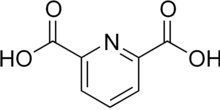Difference between revisions of "Dipicolinic acid"
(Created page with "220x220px Dipicolinic acid is a disubstituted pyridine derivative containing two carboxylic acid groups. It is commonly found in ba...") |
|||
| Line 1: | Line 1: | ||
[[File:Dipicolinic acid.png|thumb|220x220px]] | [[File:Dipicolinic acid.png|thumb|220x220px]] | ||
| − | Dipicolinic acid is a disubstituted [[pyridine]] derivative containing two [[carboxylic acid ]]groups. It is commonly found in bacterial spores, as it confers heat resistance to the endospore. It is a powerful complexation agent and has several uses in biochemistry and transition metal chemistry. | + | '''Dipicolinic acid''' is a disubstituted [[pyridine]] derivative containing two [[carboxylic acid ]]groups. It is commonly found in bacterial spores, as it confers heat resistance to the endospore. It is a powerful complexation agent and has several uses in biochemistry and transition metal chemistry. |
==Properties== | ==Properties== | ||
===Chemical=== | ===Chemical=== | ||
Dipicolinates are good chelation agents. There are multiple free electron pairs on the molecule, one on the lone nitrogen atom and two on oxygen atoms in the carboxylate groups, making it a tridentate ligand. Numerous metals will complex to the dipicolinate ion, most notably chromium and the lanthanides. | Dipicolinates are good chelation agents. There are multiple free electron pairs on the molecule, one on the lone nitrogen atom and two on oxygen atoms in the carboxylate groups, making it a tridentate ligand. Numerous metals will complex to the dipicolinate ion, most notably chromium and the lanthanides. | ||
| + | |||
===Physical=== | ===Physical=== | ||
When dipicolinic acid is added to lanthanide ions, the dipicolinato groups are able to transfer the energy of ultraviolet light to the lanthanide ion, resulting in greater fluorescence. By substituing all of the water molecules which normally coordinate to a lanthanide ion, it reduces the absorption of ultraviolet light and fluorescence is enhanced, especially in solution. | When dipicolinic acid is added to lanthanide ions, the dipicolinato groups are able to transfer the energy of ultraviolet light to the lanthanide ion, resulting in greater fluorescence. By substituing all of the water molecules which normally coordinate to a lanthanide ion, it reduces the absorption of ultraviolet light and fluorescence is enhanced, especially in solution. | ||
Dipicolinic acid melts at 248-250°C. | Dipicolinic acid melts at 248-250°C. | ||
| + | |||
==Availability== | ==Availability== | ||
Chromium dipicolinate is available as a supplement, but this is an impractical method of producing dipicolinic acid. | Chromium dipicolinate is available as a supplement, but this is an impractical method of producing dipicolinic acid. | ||
| Line 18: | Line 20: | ||
*Fluorescent compounds of [[Lanthanide|lanthanides]] | *Fluorescent compounds of [[Lanthanide|lanthanides]] | ||
*Chromatography | *Chromatography | ||
| − | ==Safety== | + | |
| + | ==Handling== | ||
| + | ===Safety=== | ||
Dipicolinic acid is an irritant. | Dipicolinic acid is an irritant. | ||
| + | |||
| + | ===Storage=== | ||
| + | In closed botles. | ||
| + | |||
| + | ===Disposal=== | ||
| + | Should be mixed with a flammable organic solvent and incinerated. | ||
==References== | ==References== | ||
<references/> | <references/> | ||
===Relevant Sciencemadness threads=== | ===Relevant Sciencemadness threads=== | ||
| + | |||
[[Category:Chemical compounds]] | [[Category:Chemical compounds]] | ||
[[Category:Organic compounds]] | [[Category:Organic compounds]] | ||
[[Category:Carboxylic acids]] | [[Category:Carboxylic acids]] | ||
[[Category:Pyridine derivatives]] | [[Category:Pyridine derivatives]] | ||
| + | [[Category:Biologically-derived compounds]] | ||
[[Category:Acids]] | [[Category:Acids]] | ||
[[Category:Aromatic compounds]] | [[Category:Aromatic compounds]] | ||
[[Category:Chelating agents]] | [[Category:Chelating agents]] | ||
| − | |||
Revision as of 21:06, 14 December 2015
Dipicolinic acid is a disubstituted pyridine derivative containing two carboxylic acid groups. It is commonly found in bacterial spores, as it confers heat resistance to the endospore. It is a powerful complexation agent and has several uses in biochemistry and transition metal chemistry.
Contents
Properties
Chemical
Dipicolinates are good chelation agents. There are multiple free electron pairs on the molecule, one on the lone nitrogen atom and two on oxygen atoms in the carboxylate groups, making it a tridentate ligand. Numerous metals will complex to the dipicolinate ion, most notably chromium and the lanthanides.
Physical
When dipicolinic acid is added to lanthanide ions, the dipicolinato groups are able to transfer the energy of ultraviolet light to the lanthanide ion, resulting in greater fluorescence. By substituing all of the water molecules which normally coordinate to a lanthanide ion, it reduces the absorption of ultraviolet light and fluorescence is enhanced, especially in solution.
Dipicolinic acid melts at 248-250°C.
Availability
Chromium dipicolinate is available as a supplement, but this is an impractical method of producing dipicolinic acid.
Preparation
Dipicolinic acid may be synthesized froom 2,6-dichloropyridine.
Projects
- Fluorescent compounds of lanthanides
- Chromatography
Handling
Safety
Dipicolinic acid is an irritant.
Storage
In closed botles.
Disposal
Should be mixed with a flammable organic solvent and incinerated.
